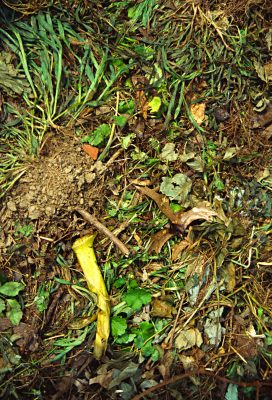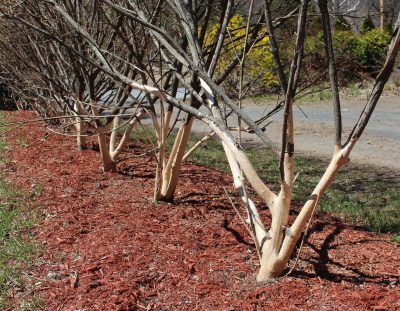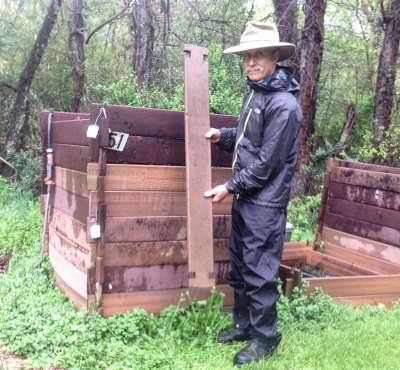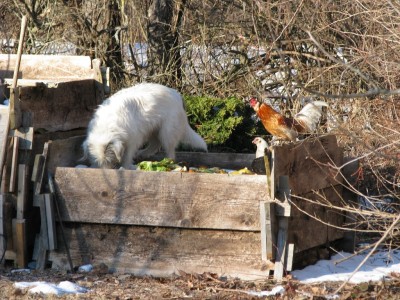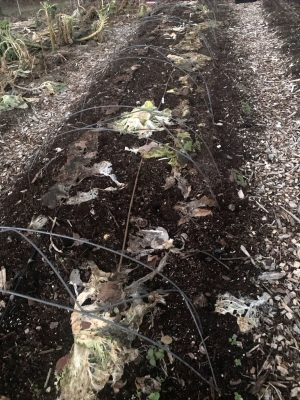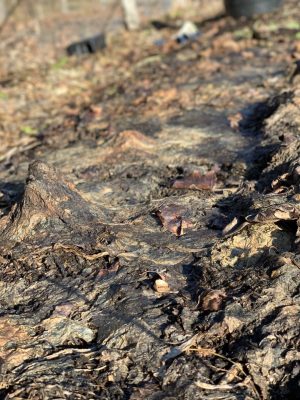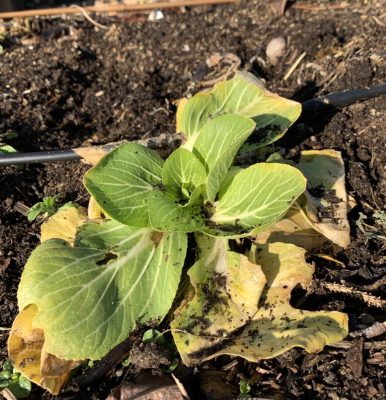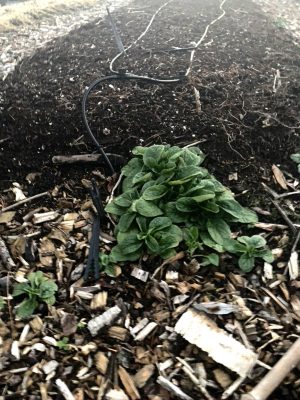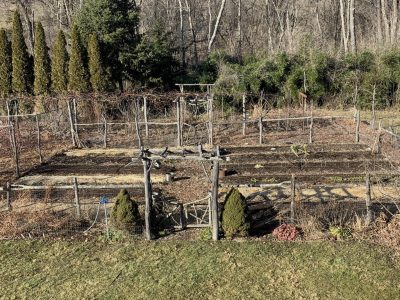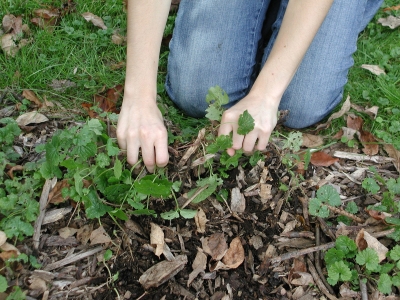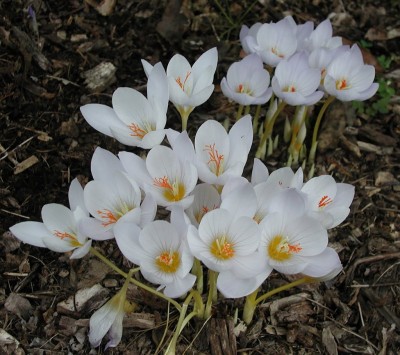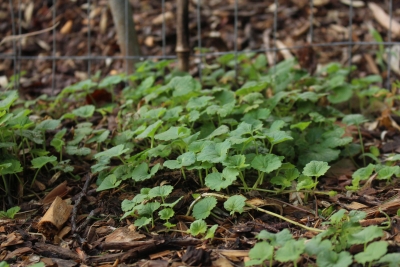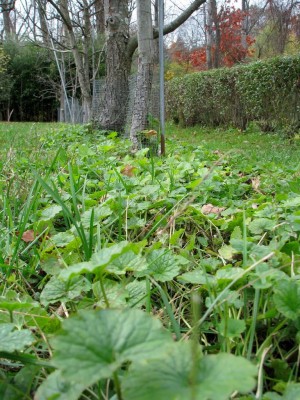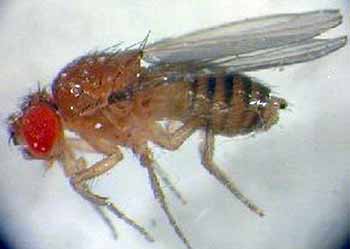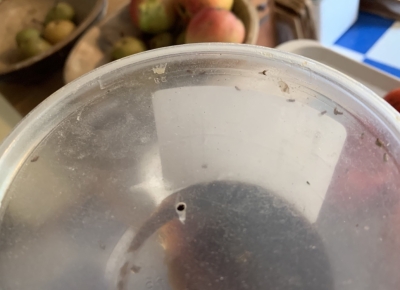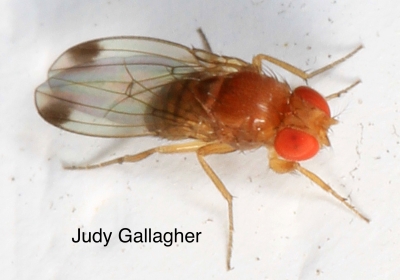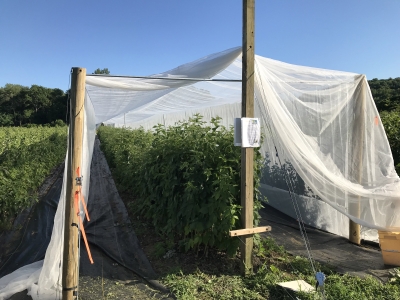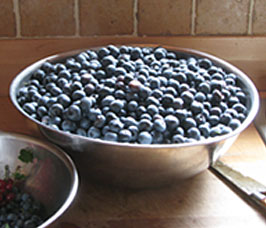PEST PLANS
My Sweet, Corn
Spring is here this week, weatherwise, at least. Not to bring back bad memories, but with real spring just around the corner, now is a good time to revisit two or three of last year’s worst pest problems, and plan some sort of counteraction. Not that those memories are really that bad; the interaction of pests, plants, the environment, and my hopefully green thumb is always interesting.
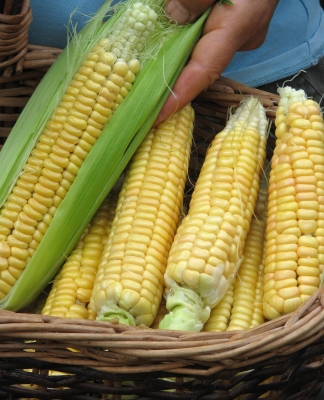 The most serious pest problem last year, most serious because it affected one of my favorite vegetables, was a disease that devastated my later plantings of corn. Looking at the symptoms — yellow streaks on leaves that turned to tan, dead areas — my diagnosis was the bacterial disease, Stewart’s wilt. Some plant pathologists pointed out that Stewart’s wilt is very rare around here, and that the problem was probably the fungal disease, northern corn leaf blight.
The most serious pest problem last year, most serious because it affected one of my favorite vegetables, was a disease that devastated my later plantings of corn. Looking at the symptoms — yellow streaks on leaves that turned to tan, dead areas — my diagnosis was the bacterial disease, Stewart’s wilt. Some plant pathologists pointed out that Stewart’s wilt is very rare around here, and that the problem was probably the fungal disease, northern corn leaf blight.
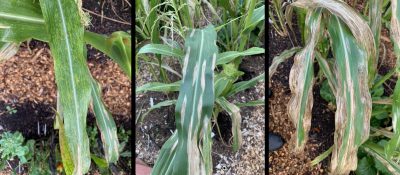
Disease development on leaves
I’m not 100% convinced it’s the blight but, more important is what to do in either case. I like my sweet corn. (Popcorn and polenta corn were unaffected.) Stewart’s wilt can be avoided by growing resistant varieties. But not only do I like my sweet corn; I like specifically Golden Bantam sweet corn.
A hundred years ago, Golden Bantam corn was bred into a number of hybrid varieties, some of which are resistant to Stewart’s wilt. Golden Cross Bantam, for example. As I said, though, I like my Golden Bantam. I’ve grown Golden Cross Bantam and its flavor fell short of Golden Bantam.

Northern Corn Leaf Blight
As a nonhybrid variety, Golden Bantam turns up in a number of strains. My seed came from a few sources, and it’s possible that some strains are more resistant than others. My two earlier ripening beds had no disease. Last year I didn’t keep records of which beds got seed from which sources. This year I’ll record it.
Northern corn leaf blight can also be controlled with resistant varieties. As I wrote, though, Golden Bantam is the variety for me, so other varieties are not an option, for now at least.
Plus, there are other options for dealing with northern corn leaf blight. Thorough cleanup at season’s end removes spores that would overwinter. Done. Not planting corn in the same bed for one to two years to starve out the disease. Done. Good air circulation and humidity control by keeping weeds in check. Not so done each year. Colder, damper air descends readily into the Wallkilll River Valley here and, while weeds are under control, I do a lot of interplanting, which has the same effect, humidity-wise, as weeds.
Who knows? Another season, different conditions. The problem, whichever it is, never showed up before; perhaps it won’t ever again.
An Unwelcome Newcomer
The other significant pest problems last year were with my onions and leeks. As usual, I started onions from seed indoors in February and planted them out in early May. Another batch got direct seeded right out in the garden in April. Both plantings — I’m ashamed to admit — yielded stunted bulbs, many no bigger than a nickel. Leeks likewise were stunted, or deformed.
Also embarrassing is that I didn’t take the trouble to examine the plants closely for clues. This would have been relatively easy since the probable culprits were leek moth or thrips, both now common, around here, at least. Plus, I’ve previously had a problem with leek moth.
Leek moth, a European native, is a relative newcomer on this side of the Atlantic, first showing up in northern New York state in 2009. Temperatures above 50°F in late winter awaken papae or adults overwintering in debris, and Ms. Leek Moth soon starts laying eggs, lots of them. In less than a month, new adults start feeding on leaves. Subsequent generations follow suit, feeding on leaves, weakening the plant, and also the parts — stalks and bulbs — that we want to eat.
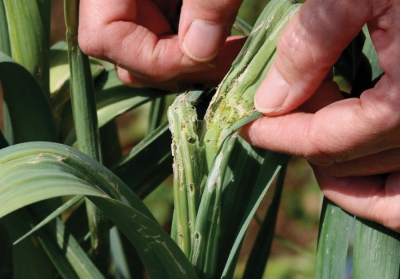
Early signs of impending damage are the eggs, tiny and transluscent and laid on the undersides of the leaves. Or, later, the caterpillars, slender, yellow and also small, less than one-half inch long. The important thing is to take action at the first signs of damage — holes in leaves and caterpillars. To see the caterpillars, leaves of garlic and leeks need to be unfolded; hollow leaves of onions need to be opened for an inside look.

Leek moth damage, later
Preemptive action would be to use a lightweight floating row cover beginning early in the season to keep Ms. Leek Moth from laying eggs on plants.
Once damage or caterpillars is found, spraying, my least favorite garden activity, is needed. Organic sprays include Pyganic, which is effective for a couple of days, or, more lasting, Entrust, a natural substance made by a soil bacterium. In either case sprays need to be applied strictly according to label directions, both for effectiveness and for legality
Thrip, Thrip, Thrip – No, Not a Frog
Thrips, the other possible, or additional, culprits are very small, but their damage is telling: silver lines and/or small white patches on leaves and tip dieback. To see the culprits themselves, you’ve got to look closely between the leaf folds, zeroing in on the youngest leaves, for light yellow nymphs and darker adults. Hot, dry weather suits them best, which were the conditions here last summer.

Thrip damage
Because thrips overwinter in debris, thorough cleanup helps. Straw mulch has potential, although one study showed that while it reduced the number of thrips, it didn’t affect yield. It did increase the number of jumbo onions, though. Go figure.
Certain kinds of onions are more resistant to thrips than others. In general, red onions (which I anyway don’t grow) are very susceptible, yellow ones (which I do grow) less so, and Sweet Spanish onions (which I have grown in the past) are relatively resistant. I’ll no longer grow the variety Candy, which is listed as susceptible.
Certain plants, on which thrips do little damage, can draw thrips away from the onions. Carrots, tomatoes, cabbage and its kin, carnations, and chrysanthemums, as examples.
And, of course, there are organic sprays, a last resort for me. Beauvaria, a naturally-occuring insect killer, for one. Also the relatively benign insecticidal soap paired with Neem. And again, Entrust.
As I said, I’m not bemoaning these insect and disease pests. It’s reassuring for me to stop and think how few or no pest problems vegetables typically affect my kale, tomatoes, peppers, okra, and most other vegetables grow. They all grow well with little more than yearly additions of compost to the beds, and timely planting and watering.
Prune Fearlessly
A reminder that I’ll be holding a FEARLESS PRUNING webinar on March 29, 2021 from 7-8:30pm EST. This webinar will take the mystery out of pruning, so that you can prune your lilac and rose bushes, apple trees, blueberry shrubs — all trees and shrubs, in fact — to look their best and be in vibrant health. Fearlessly. For more information and to register, go to www.leereich.com/workshops.

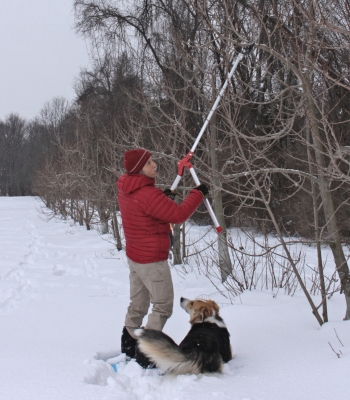

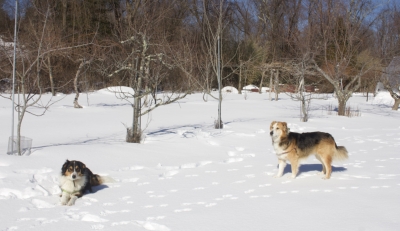
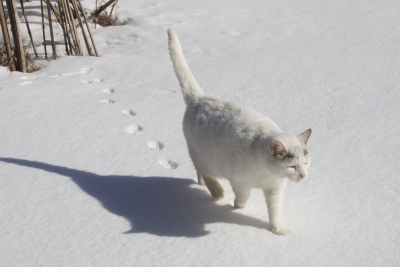

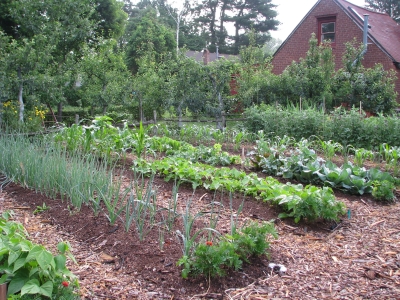
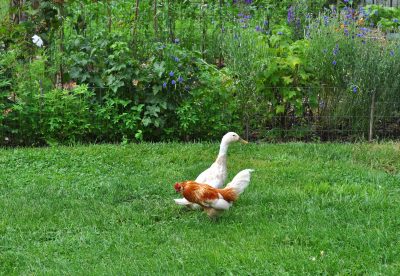
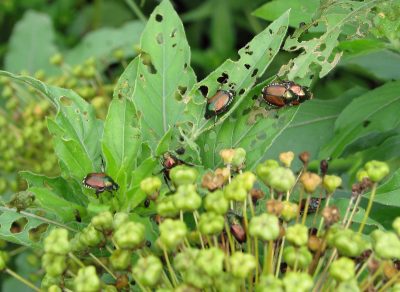

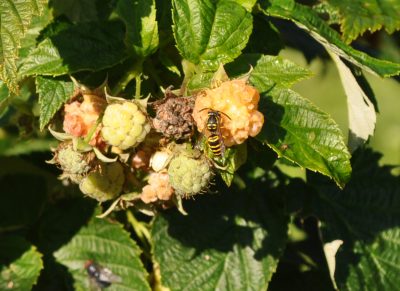

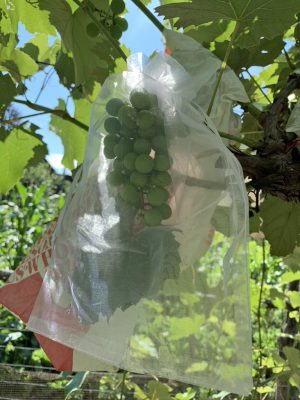 The first grapes of the season, Somerset Seedless and Glenora, started ripening towards the end of August. The first of these varieties is one of many bred by the late Wisconsin dairy farmer cum grape breeder Elmer Swenson. The fruits of his labors literally run the gamut from varieties, such as Edelweiss, having strong, foxy flavor (the characteristic flavor component of Concord grapes and many American-type grapes) to those with mild, fruity flavor reminiscent of European-type grapes. Somerset Seedless is more toward the latter end of the spectrum and, of course, it’s seedless. Swenson red and Briana, which are ripe as you read this, are more in the middle of the spectrum.
The first grapes of the season, Somerset Seedless and Glenora, started ripening towards the end of August. The first of these varieties is one of many bred by the late Wisconsin dairy farmer cum grape breeder Elmer Swenson. The fruits of his labors literally run the gamut from varieties, such as Edelweiss, having strong, foxy flavor (the characteristic flavor component of Concord grapes and many American-type grapes) to those with mild, fruity flavor reminiscent of European-type grapes. Somerset Seedless is more toward the latter end of the spectrum and, of course, it’s seedless. Swenson red and Briana, which are ripe as you read this, are more in the middle of the spectrum.
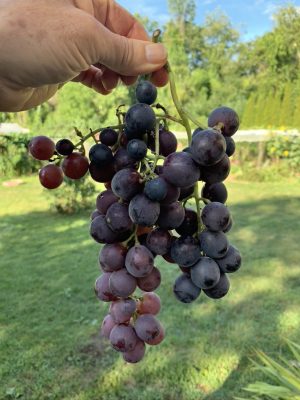
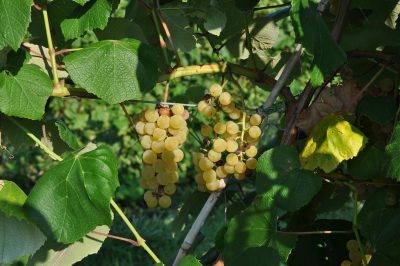
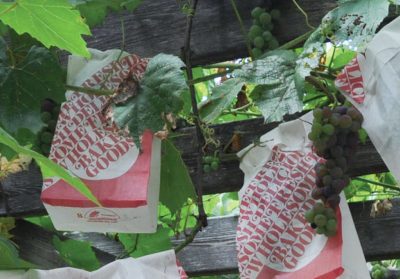 Perhaps the label made the bags even less attractive to grape-hungry birds and insects; at any rate, they worked very well, usually yielding almost 100 late harvest, delectably sweet and flavorful, perfect bunches of bagged grapes each year.
Perhaps the label made the bags even less attractive to grape-hungry birds and insects; at any rate, they worked very well, usually yielding almost 100 late harvest, delectably sweet and flavorful, perfect bunches of bagged grapes each year.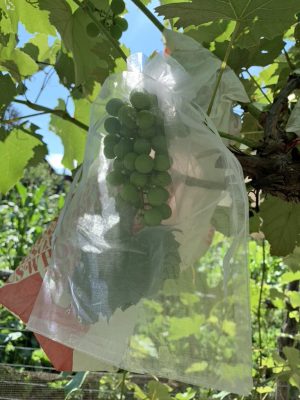 Organza is an open weave fabric often made from synthetic fiber. Small organza bags typically enclose wedding favors; the bags come in many sizes. Organza bags have the advantage over paper bags of letting in more light. A mere pull of the two drawstrings makes bagging the fruit very easy; paper bags involve cutting, folding, and stapling. Organza bags also re-usable. (The bags also work well with apples which, in contrast to grapes, require sunlight to color up.)
Organza is an open weave fabric often made from synthetic fiber. Small organza bags typically enclose wedding favors; the bags come in many sizes. Organza bags have the advantage over paper bags of letting in more light. A mere pull of the two drawstrings makes bagging the fruit very easy; paper bags involve cutting, folding, and stapling. Organza bags also re-usable. (The bags also work well with apples which, in contrast to grapes, require sunlight to color up.)

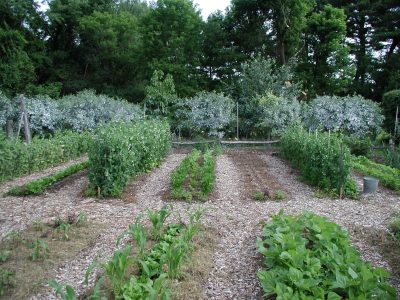
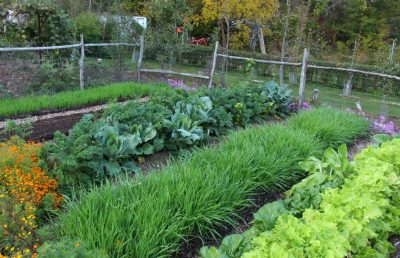
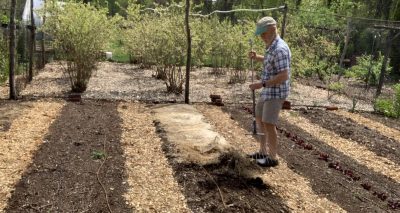
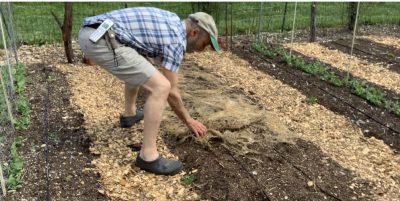
 Yes, I know the plant is pretty, provides early nectar for pollinators, and is edible. But its out of place in my vegetable beds. The tarp does it in.
Yes, I know the plant is pretty, provides early nectar for pollinators, and is edible. But its out of place in my vegetable beds. The tarp does it in.